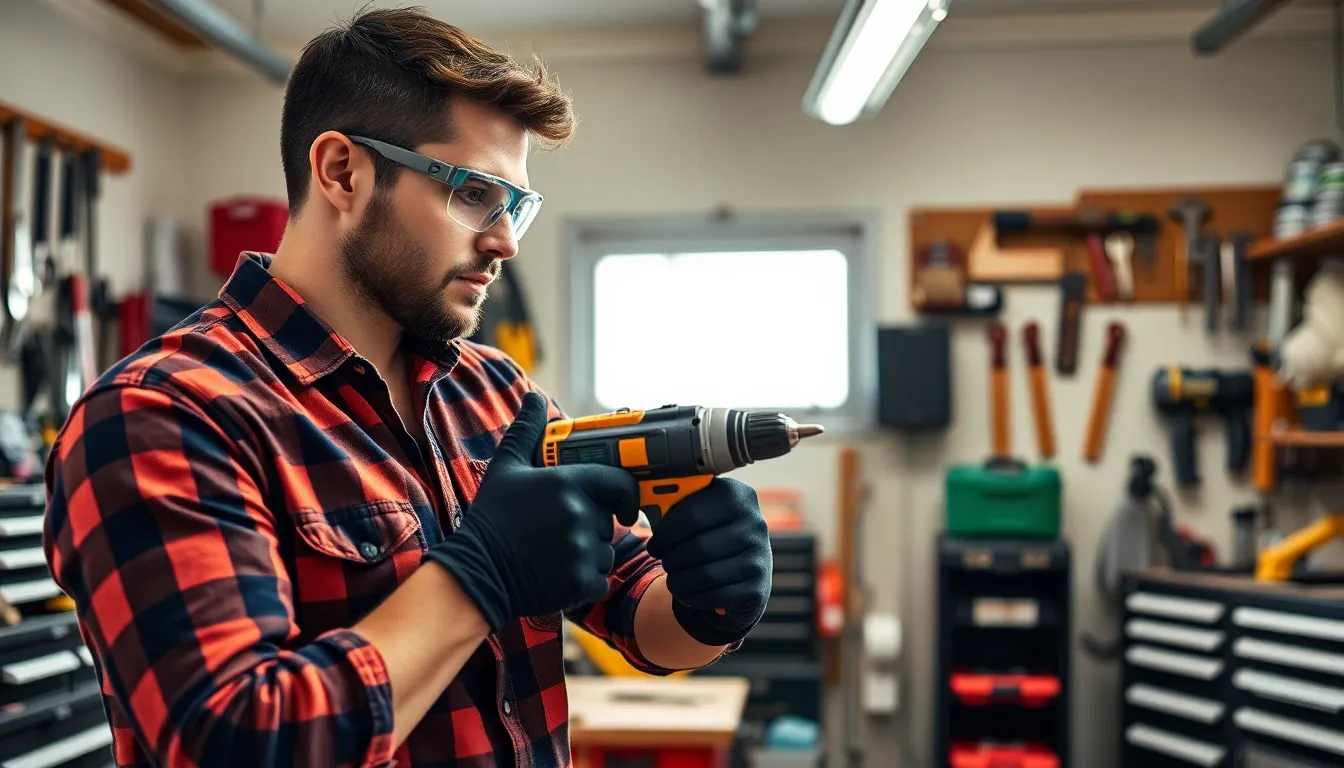Table of Contents
ToggleIn a world where DIY projects can turn into epic fails faster than you can say “where’s my toolbox,” mastering the art of tool usage is essential. Whether it’s a simple home repair or a grand renovation, knowing how to wield your tools like a pro can save time, money, and a whole lot of frustration. Forget the days of wrestling with a drill or playing hide-and-seek with the right screwdriver.
Essential Tool Usage Tips
Mastering tool usage significantly enhances the DIY experience. Understanding tools and respecting safety protocols prevents mistakes and injuries.
Understanding Different Types of Tools
Familiarity with tools is essential for any DIY project. Power tools, like drills and saws, offer efficiency but require caution. Hand tools, such as hammers and screwdrivers, allow for precision in smaller tasks. Recognizing the right tool for each job affects both outcomes and efficiency. Specialty tools exist for specific projects. Ensuring access to different types protects against limitations during work.
Safety Precautions When Using Tools
Prioritizing safety ensures a productive environment. Wearing protective gear, such as goggles and gloves, minimizes injury risks. Inspecting tools before use helps identify potential hazards, like damage or wear. Maintaining a clean workspace prevents accidents caused by clutter. Following manufacturer guidelines enables safe operation of tools. Staying focused while working prevents distractions that can lead to injuries.
Common Tool Usage Techniques

Mastering proper tool usage techniques enhances efficiency and safety during DIY projects. Understanding how to grip tools and maintain them can significantly affect performance.
How to Properly Grip and Hold Tools
A secure grip enhances control and precision. Use both hands when necessary, especially with larger tools like drills or saws. The dominant hand should perform the action, while the other stabilizes the tool. Maintain a firm, yet relaxed grip to reduce fatigue. Keep fingers away from cutting edges when using sharp tools. Angle tools appropriately to align with the workpiece, ensuring accuracy. Position yourself comfortably to maintain balance and avoid strain.
Maintenance Tips for Longevity
Regular maintenance ensures tools remain effective and safe. Clean tools after each use to remove debris and prevent corrosion. Inspect blades for dullness and replace them as needed. Lubricate moving parts to ensure smooth operation. Store tools in a dry, organized manner to prevent damage. Check power cords for frays and wear regularly. Following the manufacturer’s guidelines for care and usage increases tool lifespan.
Tools for Specific Tasks
Choosing the right tools enhances efficiency and effectiveness in completing tasks. Specific tools serve unique functions, making them essential for various projects.
Gardening Tools Usage Tips
Gardening tools play a crucial role in maintaining healthy gardens. Pruning shears, used for trimming plants, ensure clean cuts for better growth and recovery. Shovels and trowels facilitate digging and transferring soil, optimizing planting. Rakes gather leaves and debris, keeping garden areas tidy. When using a hose, adjust the nozzle to control water flow and pressure effectively. Wearing gloves protects hands from thorns and dirt while providing a better grip on tools. Regularly cleaning and storing tools properly prevents rust and prolongs their lifespan.
DIY Home Improvement Tools
DIY home improvement tools are essential for projects around the house. Power drills make drilling holes quick and easy, especially when switching bits. Tape measures ensure accurate measurements, avoiding costly mistakes when cutting materials. Levelers help maintain straight lines and prevent uneven installations. Experience the efficiency of stud finders when locating beams behind walls, simplifying the installation of shelves or heavy fixtures. Don’t forget safety goggles, which protect eyes during tasks like cutting or sanding. Maintaining tools through regular inspection and cleaning maximizes performance and safety during DIY projects.
Advanced Tool Usage Tips
Mastering advanced tool techniques can elevate the quality of any DIY project. Familiarity with tool features ensures efficient operation. For precise cuts, use clamps to stabilize materials, allowing hands-free cutting.
Understanding specific power tool settings leads to better outcomes. Always adjust speed levels based on the material being worked with. Different surfaces require varied blade types; matching the blade to the job enhances performance.
Utilizing ergonomic tools contributes to comfort during prolonged use. Choosing tools that fit well in hand reduces fatigue and increases control. Stay organized by keeping tools in designated areas, making them easy to locate during projects.
Invest in multi-functional tools to reduce storage needs while enhancing versatility. Tools like oscillating multi-tools can tackle various tasks, from sanding to cutting. Regularly reviewing tool inventories ensures they remain sufficient for ongoing projects.
Experimenting with new techniques can broaden skills and improve efficiency. Consider attending workshops or tutorials for firsthand experience with advanced methods. Learning from experts often uncovers tips that streamline work processes.
Keep safety as a priority when engaging in advanced projects. Using tool guards and proper attire minimizes injury risks. Emergency plans should be established to address potential tool-related accidents, assuring a safe working environment.
Tracking tool usage and performance over time helps identify wear or the need for replacement. Scheduling regular maintenance prevents unexpected failures that can halt progress.
Being proactive with tool care not only extends lifespan but also enhances safety and effectiveness.
Mastering tool usage is essential for anyone looking to tackle DIY projects effectively. By understanding the nuances of different tools and implementing safety measures, individuals can enhance their skills and confidence. Regular maintenance and proper storage not only prolong the life of tools but also ensure they perform at their best.
Investing time in learning advanced techniques and experimenting with new methods can significantly elevate project outcomes. Staying organized and choosing the right tools for specific tasks streamlines the process, making DIY endeavors more enjoyable. Prioritizing safety and proactive care will lead to successful and fulfilling home improvement experiences.





